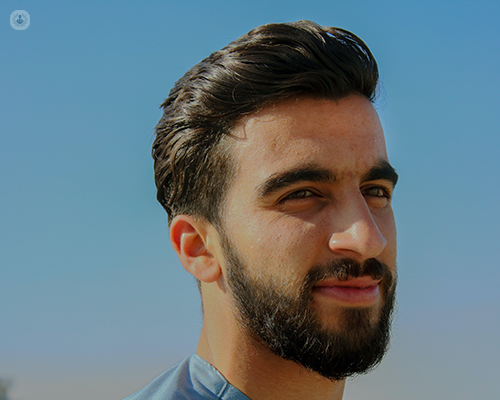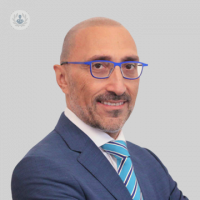Looking at FUE and strip FUT: Which hair transplant technique best fits my needs?
Escrito por:A hair transplant is a surgical procedure to move existing hair in your body to a thin or bald area in your scalp. If you consider a hair transplant, you will need to assess your current situation, the options available, and the best solution for you. The two main types of hair transplant surgery, FUE and Strip FUT, have high patient satisfaction rates and proven results, but how can you know which one best fits your needs?
In this article, founding director of the award-winning Farjo Hair Institute, Dr Bessam Farjo, provides an expert insight into what FUE and strip FUT involve, what patients can expect, and what are the major benefits and drawbacks of each method.

What is the FUE technique?
FUE, or Follicular Unit Excision, is the individual extraction of groups of hair follicles before their later transplant into the recipient area of the scalp. It usually involves an area of the scalp being shaved and the individual excision of follicular unit grafts, using a cylindrical punch tool which measures 0.8 - 1mm approximately. The procedure is carried out manually or with a motorised tool, leaving subtle-looking small dot scars on the scalp. These are unnoticeable in most cases with any length of hair due to their small size, but may be seen with a full shave.
For the majority of patients, this method is more preferred to strip FUT, because it is a very small incision for each follicle removal and it heals very quickly. A medically qualified professional should perform this excision, because it is a surgical step. Overall, FUE safely obtains fewer hair grafts per procedure usually than strip FUT, but still should yield around 5000 hairs in one day.
What can patients expect during and after the surgery?
Very small slits will be made in the receiving area by the surgeon, where the follicular grafts will be placed. A good positioning of the grafts will ensure that the hair looks natural when it grows.
FUE can be done under local anaesthetic, which makes the intervention nearly painless apart from the initial injections, but it is generally more time-consuming than a FUT procedure. After the surgery, new hairs will become noticeable in approximately three to four months, and these will continue to grow throughout the next eight to 15 months.
What are the disadvantages of FUE?
The downsides to FUE include:
- Higher risk of donor hair wastage if not performed by a skilled and experienced surgeon
- More vulnerable grafts, due to them having less protective tissue around the root than those transplanted via strip FUT
- Donor area has to be shaved usually, to provide a clear picture of the hair follicles
Still, for many patients, the benefits of FUE are greater than the risks.
What are the benefits of FUE?
FUE has gradually grown in popularity over the years and benefits include:
- No linear scar left, making it convenient for shorter hairstyles
- Feels less of a surgical procedure to the patient
- A shorter recovery time in terms of sensation, but more obvious visually perhaps
- Minimal visible scarring – scars are small and scattered across the donor scalp
- Surgeon can control the exact number and type of grafts, ensuring a more efficient transplant need
What is the strip FUT technique?
Strip FUT, or Strip Follicular Unit Transplantation, is the removal of a strip of skin – full with hairs and follicle groups – before its later microscopically dissected to separate the hair follicle groups into grafts. These grafts are then inserted into the recipient area.
This method commonly involves a strip of hair-bearing skin being taken from the scalp - usually from the back and the sides of the head, because this is where you have more hair density and ones that are not affected by the balding process. Through an observation of the hair density and the looseness of the skin on the scalp, the surgeon will be able to assess if strip FUT is the right choice. Strip FUT has been continually refined over the years and in the right hands, should leave the patient with a fine and well disguised linear scar amongst existing hair.
What can patients expect during and after the surgery?
The surgical assistants start by dividing the strip of skin into tiny grafts of individual follicular units, comprising one to four hairs each, with the use of high-powered microscopes. Until the grafts are needed, they are kept in a tissue storage solution.
The site where the strip of hair is taken from is then sutured or stapled, but this is not noticeable due to the surrounding hair covering the area. A linear scar will be formed eventually, completely camouflaged with surrounding hair, where the area has healed.
People with more advanced hair loss who require large amounts of grafts - up to 4500 grafts or 9000 hairs in a day - to be transplanted, usually benefit the most from this procedure. Other candidates include women and man-to-woman transgender patients as this technique avoids shaving.
Compared to FUE, what are the benefits of strip FUT?
Strip FUT has several advantages over FUE, including:
- No need for the donor area to be shaved
- Existing hair can be kept long and used to cover up the linear scar
- If needed, more hair can be transplanted in a day, and at a lower cost
- Suitable for patients who want to achieve maximum coverage from their hair restoration, especially if the hair loss is advanced
- Hairs are taken from the most dense and future proof part of the scalp
- Lower risk of the hair units perishing than with FUE, as they are usually more robust.
Both FUE and Strip FUT surgeries have benefits and disadvantages and the best treatment plan depends on the individual case.
Dr Bessam Farjo is a world-leading hair transplant surgeon, founding director of Farjo Hair Institute in Manchester and London, and a hair loss expert. If you’re concerned about your hair loss, or simply wish to know more about hair transplant surgery, don’t hesitate to visit Dr Farjo’s Top Doctors profile today.


